Southern Europe
Some definitions of southern Europe, also known as Mediterranean Europe, include the countries of the Iberian peninsula (Spain and Portugal), the Italian peninsula, Southern France, Greece and Malta.[1] Other definitions sometimes include the Balkan countries of southeast Europe, which are geographically technically in the southern part of Europe, but which have different historical, political, economic, and cultural backgrounds that commonly places them in the category of Eastern Europe.

.png)
Different methods can be used to define southern Europe, including its political, economic, and cultural attributes. Southern Europe can also be defined by its natural features — its geography, climate, and flora.
Geography
Geographically, southern Europe is the southern half of the landmass of Europe. This definition is relative, with no clear limits.
Countries geographically considered part of southern Europe include:
- Southwestern Europe
Countries whose borders lie within southwestern Europe :
- South-central Europe
Countries whose borders lie within south-central Europe:
-
 Italy (sometimes excluding northern Italy)[2]
Italy (sometimes excluding northern Italy)[2] -
 San Marino
San Marino -
 Vatican City
Vatican City
- Southeastern Europe
Countries whose borders lie within southeastern Europe (Balkan peninsula) :
-
 Albania
Albania -
 Bosnia and Herzegovina
Bosnia and Herzegovina -
 Bulgaria
Bulgaria -
 Croatia
Croatia -
 Greece
Greece -
 Kosovo[lower-alpha 1]
Kosovo[lower-alpha 1] -
 Macedonia
Macedonia -
 Montenegro
Montenegro -
 Romania
Romania -
 Serbia
Serbia -
 Slovenia
Slovenia -
 Turkey (only East Thrace)[3][4][5]
Turkey (only East Thrace)[3][4][5]
- Major islands
Climate
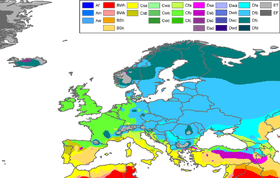
Southern Europe's most emblematic climate is that of the Mediterranean climate, which has become a typically known characteristic of the area. The Mediterranean climate covers much of Portugal, Spain, Southeast France, Italy, Croatia, Albania, Montenegro, Greece, the Western and Southern coastal regions of Turkey as well as the Mediterranean islands. Those areas of Mediterranean climate present similar vegetations and landscapes throughout, including dry hills, small plains, pine forests and olive trees.
Cooler climates can be found in certain parts of Southern European countries, for example within the mountain ranges of Spain and Italy. Additionally, the north coast of Spain experiences a wetter Atlantic climate.
Flora
.png)
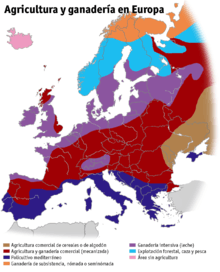
Southern Europe's flora is that of the Mediterranean Region, one of the phytochoria recognized by Armen Takhtajan. The Mediterranean and Submediterranean climate regions in Europe are found in much of Southern Europe, mainly in Southern Portugal, most of Spain, the southern coast of France, Italy, the Croatian coast, much of Bosnia, Montenegro, Kosovo, Serbia, Albania, Macedonia, Greece, and the Mediterranean islands.[6]
Population
| Country | Area (km²) |
Population (2010 est.) |
Population density (per km²) |
Capital |
|---|---|---|---|---|
| |
28,748 | 2,821,977 | 111.1 | Tirana |
| |
468 | 84,082 | 179.8 | Andorra la Vella |
| |
51,129 | 4,613,414 | 90.2 | Sarajevo |
| |
110,994 | 7,364,570 | 77 | Sofia |
| |
56,594 | 4,489,409 | 81 | Zagreb |
| |
6.8 | 29,431 | 4,328 | Gibraltar |
| |
131,990 | 11,295,002 | 85.3 | Athens |
| |
301,338 | 60,418,711 | 200.5 | Rome |
| |
10,908 | 1,859,203 | 170.4 | Prishtina |
| |
25,713 | 2,114,550 | 82.2 | Skopje |
| |
316 | 412,966 | 1,306.8 | Valletta |
| |
13,812 | 672,181 | 50 | Podgorica |
| |
92,090 | 11,317,192 | 114 | Lisbon |
| |
61 | 31,716 | 501 | City of San Marino |
| |
77,474 | 7,120,666 | 102.46 | Belgrade |
| |
20,273 | 2,054,199 | 99.6 | Ljubljana |
| |
504,030 | 46,030,109 | 93 | Madrid |
| |
23,764 | 10,620,739 | 446.9 | Ankara |
| |
0.44 | 826 | 1877 | Vatican City |
| Total | 1,338,694 | 164,127,170 | 122.60 |
Largest urban areas
| Rank | Urban Area | State | Population[7] | Density (per km²) |
|---|---|---|---|---|
| 1 | İstanbul (European part) | 8,963,431 | 2,620 | |
| 2 | Madrid | 6,171,000 | 4,600 | |
| 3 | Milan | 5,257,000 | 2,800 | |
| 4 | Barcelona | 4,693,000 | 4,300 | |
| 5 | Rome | 3,906,000 | 3,400 | |
| 6 | Naples | 3,706,000 | 3,600 | |
| 7 | Athens | 3,484,000 | 5,000 | |
| 8 | Lisbon | 2,666,000 | 2,800 | |
| 9 | Belgrade | 1,700,000 | 3,300 | |
| 10 | Valencia | 1,561,000 | 5,700 | |
History
Early history
The period known as classical antiquity began with the rise of the city-states of Ancient Greece. Greek influence reached its zenith under the expansive empire of Alexander the Great, spreading throughout Asia.
The Roman Empire came to dominate the entire Mediterranean basin in a vast empire based on Roman law and Roman legions. It promoted trade, tolerance, and Greek culture. By 300 AD the Roman Empire was divided into the Western Roman Empire based in Rome, and the Eastern Roman Empire based in Constantinople. The attacks of the Germanic peoples of northern Europe led to the Fall of the Western Roman Empire in AD 476, a date which traditionally marks the end of the classical period and the start of the Middle Ages.
During the Middle Ages, the Eastern Roman Empire survived, though modern historians refer to this state as the Byzantine Empire. In Western Europe, Germanic peoples moved into positions of power in the remnants of the former Western Roman Empire and established kingdoms and empires of their own.
The period known as the Crusades, a series of religiously motivated military expeditions originally intended to bring the Levant back into Christian rule, began. Several Crusader states were founded in the eastern Mediterranean. These were all short-lived. The Crusaders would have a profound impact on many parts of Europe. Their Sack of Constantinople in 1204 brought an abrupt end to the Byzantine Empire. Though it would later be re-established, it would never recover its former glory. The Crusaders would establish trade routes that would develop into the Silk Road and open the way for the merchant republics of Genoa and Venice to become major economic powers. The Reconquista, a related movement, worked to reconquer Iberia for Christendom.
The Late Middle Ages represented a period of upheaval in Europe. The epidemic known as the Black Death and an associated famine caused demographic catastrophe in Europe as the population plummeted. Dynastic struggles and wars of conquest kept many of the states of Europe at war for much of the period. In the Balkans, the Ottoman Empire, a Turkish state originating in Anatolia, encroached steadily on former Byzantine lands, culminating in the Fall of Constantinople in 1453.
Post-Middle Ages
Beginning roughly in the 14th century in Florence, and later spreading through Europe with the development of the printing press, a Renaissance of knowledge challenged traditional doctrines in science and theology, with the Arabic texts and thought[8] bringing about rediscovery of classical Greek and Roman knowledge.
The Reconquista of Portugal and Spain led to a series of oceanic explorations resulting in the Age of Discovery that established direct links with Africa, the Americas, and Asia, while religious wars continued to be fought in Europe, which ended in 1648 with the Peace of Westphalia. The Spanish crown maintained its hegemony in Europe and was the leading power on the continent until the signing of the Treaty of the Pyrenees, which ended a conflict between Spain and France that had begun during the Thirty Years' War. An unprecedented series of major wars and political revolutions took place around Europe and indeed the world in the period between 1610 and 1700. Observers at the time, and many historians since, have argued that wars caused the revolutions.[9] Galileo Galilei, invented the telescope and the thermometer which allowed him to observe and describe the solar system. Leonardo da Vinci painted the most famous work in the world.[10] Guglielmo Marconi invented the radio.[11]
European overseas expansion led to the rise of colonial empires, producing the Columbian Exchange.[12] The combination of resource inflows from the New World and the Industrial Revolution of Great Britain, allowed a new economy based on manufacturing instead of subsistence agriculture.[13]
The period between 1815 and 1871 saw a large number of revolutionary attempts and independence wars. Balkan nations began to regain independence from the Ottoman Empire. Italy unified into a nation state. The capture of Rome in 1870 ended the Papal temporal power. Rivalry in a scramble for empires spread in what is known as The Age of Empire.
20th century
The outbreak of World War I in 1914 was precipitated by the rise of nationalism in Southeastern Europe as the Great Powers took up sides. The Allies defeated the Central Powers in 1918. During the Paris Peace Conference the Big Four imposed their terms in a series of treaties, especially the Treaty of Versailles.
The Nazi regime under Adolf Hitler came to power in 1933, and along with Mussolini's Italy sought to gain control of the continent by the Second World War. Following the Allied victory in the Second World War, Europe was divided by the Iron Curtain. The countries in Southeastern Europe were dominated by the Soviet Union and became communist states. The major non-communist Southern European countries joined a US-led military alliance (NATO) and formed the European Economic Community amongst themselves. The countries in the Soviet sphere of influence joined the military alliance known as the Warsaw Pact and the economic bloc called Comecon. Yugoslavia was neutral.
Italy became a major industrialized country again, due to its post-war economic miracle. The European Union (EU) involved the division of powers, with taxation, health and education handled by the nation states, while the EU had charge of market rules, competition, legal standards and environmentalism. The Soviet economic and political system collapsed, leading to the end of communism in the satellite countries in 1989, and the dissolution of the Soviet Union itself in 1991. As a consequence, Europe's integration deepened, the continent became depolarised, and the European Union expanded to subsequently include many of the formerly communist European countries – Romania and Bulgaria (2007) and Croatia (2013).
Languages
The following table shows the languages in Southern Europe that are spoken by at least five million people in the region:
| Language | Speakers[lower-alpha 2] | Principal Southern European country / countries |
|---|---|---|
| Italian | 59,400,000 [14] | |
| Spanish | 46,000,000+ [15] | |
| Serbo-Croatian | 20,000,000+ [16] | |
| Greek | 13,432,490 [17] | |
| Bulgarian-Macedonian | 11 500 000 [18] | |
| Turkish | 10,934,365 [19][20] | |
| Portuguese | 10,000,000 [21] | |
| Catalan | 10,000,000 [22][23] | |
| Albanian | 5,400,000 | |
Romance languages
The most widely spoken family of languages in southern Europe are the Romance languages, the heirs of Latin, which have spread from the Italian peninsula, and are emblematic of Southwestern Europe. (See the Latin Arch.) By far the most common Romance languages in Southern Europe are Italian (spoken by over 50 million people in Italy, San Marino, and the Vatican) and Spanish, which is spoken by over 40 million people in Spain and Gibraltar. Other common Romance languages include Romanian (spoken in Romania and Moldova), Portuguese (spoken in Portugal), Catalan (spoken in eastern Spain), Galician (spoken in northwestern Spain) and Occitan, which is spoken in the Val d'Aran in Catalonia, in the Occitan Valleys in Italy and finally in southern France.
Other languages
The Hellenic languages or Greek language are widely spoken in Greece and in the Greek part of Cyprus. Additionally, other varieties of Greek are spoken in small communities in parts of other European counties.
Several South Slavic languages are spoken by millions of people in Southern Europe. Serbian is spoken in Serbia, Montenegro, Bosnia, and Croatia; Bulgarian is spoken in Bulgaria; Croatian is spoken in Croatia and Bosnia; Bosnian is spoken in Bosnia; Slovene is spoken in Slovenia; and Macedonian is spoken in Macedonia.
English is used as a second language in parts of Southern Europe. As a primary language, however, English has only a small presence in Southern Europe, only in Gibraltar (alongside Spanish) and Malta (secondary to Maltese).
There are other language groupings in Southern Europe. Albanian is spoken in Albania, Kosovo, Macedoonia, and parts of Greece. Maltese is a Semitic language that is the official language of Malta, descended from Siculo-Arabic, but written in Latin script with heavy Latin and Italian influences. The Basque language is spoken in the Basque Country, a region in northern Spain and southwestern France.
Transport
The following table shows the busiest airports in Southern Europe in 2013.
| Rank | Country | Airport | City | Passengers (2012) | Passengers (2013) | Change 2012-2013 |
|---|---|---|---|---|---|---|
| 1 | Turkey | İstanbul Atatürk Airport | İstanbul | 44,998,508 | 51,320,875 | |
| 2 | Spain | Barajas Airport | Madrid | 45,190,528[24] | 39,735,618[24] | |
| 3 | Italy | Leonardo da Vinci–Fiumicino Airport | Rome | 36,980,911[25] | 36,166,345[25] | |
| 4 | Spain | Barcelona El Prat Airport | Barcelona | 35,144,503[24] | 35,216,828[24] | |
| 5 | Spain | Palma de Mallorca Airport | Palma de Mallorca | 22,666,858[24] | 22,768,032[24] | |
| 6 | Italy | Malpensa Airport | Milan | 18,537,301[25] | 17,955,075[25] | |
| 7 | Portugal | Lisbon Portela Airport | Lisbon | 15,301,176[26] | 16,008,848[26] | |
| 8 | Spain | Málaga Airport | Málaga | 12,581,944[24] | 12,925,186[24] | |
| 9 | Greece | Athens International Airport | Athens | 12,944,041[27] | 12,536,057[27] | |
| 10 | France | Nice Côte d'Azur Airport | Nice | 11,189,896[28] | 11,554,195[28] | |
Religion
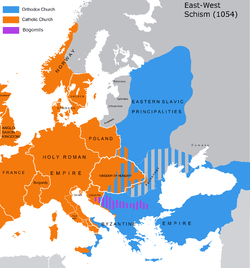
The predominant religion is southern Europe is Christianity. Christianity spread throughout Southern Europe during the Roman Empire, and Christianity was adopted as the official religion of the Roman Empire in the year 380 AD. Due to the historical break of the Christian Church into the western half based in Rome and the eastern half based in Constantinople, different branches of Christianity are prodominent in different parts of Europe. Christians in the western half of Southern Europe — e.g., Portugal, Spain, Italy — are generally Roman Catholic. Christians in the eastern half of Southern Europe — e.g., Greece, Macedonia — are generally Greek Orthodox.
Additionally, there are countries in the eastern part of Southern Europe (e.g., Bosnia, Albania, Turkey), where Islam is widely practiced.
Other classifications
- United Nations geoscheme
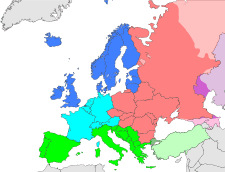
For its official works and publications, the United Nations Organization groups countries under a classification of regions. The assignment of countries or areas to specific groupings is for statistical convenience and does not imply any assumption regarding political or other affiliation of countries or territories by the United Nations.[30] Southern Europe, as grouped for statistical convenience by the United Nations (the sub-regions according to the UN), includes following countries and territories:[31]
 Albania
Albania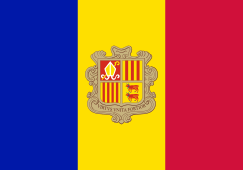 Andorra
Andorra Bosnia and Herzegovina
Bosnia and Herzegovina Croatia
Croatia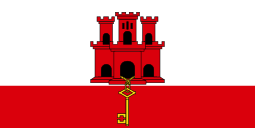 Gibraltar (UK - British overseas territory)
Gibraltar (UK - British overseas territory) Greece (including: Aegean Islands, Crete, and Ionian Islands)
Greece (including: Aegean Islands, Crete, and Ionian Islands) Italy (including: Sardinia and Sicily)
Italy (including: Sardinia and Sicily) Macedonia
Macedonia Malta (including: Gozo)
Malta (including: Gozo) Montenegro
Montenegro Portugal (including: Madeira and Azores)
Portugal (including: Madeira and Azores) San Marino
San Marino Serbia
Serbia Slovenia
Slovenia-
 Spain (including: Balearic Islands, Canary Islands, Ceuta, Melilla, and plazas de soberanía)
Spain (including: Balearic Islands, Canary Islands, Ceuta, Melilla, and plazas de soberanía)  Vatican City
Vatican City
- European Travel Commission classification
European Travel Commission divides the European region on the basis of Tourism Decision Metrics (TDM) model. Countries which belong to the Southern/Mediterranean Europe are:[32]
 Albania
Albania Bulgaria
Bulgaria Bosnia and Herzegovina
Bosnia and Herzegovina Croatia
Croatia Cyprus
Cyprus Italy
Italy Greece
Greece Macedonia
Macedonia Malta
Malta Montenegro
Montenegro Serbia
Serbia Slovenia
Slovenia Spain
Spain Turkey
Turkey
See also
| Wikimedia Commons has media related to Southern Europe. |
Notes
- ↑ Kosovo is the subject of a territorial dispute between the Republic of Kosovo and the Republic of Serbia. The Republic of Kosovo unilaterally declared independence on 17 February 2008, but Serbia continues to claim it as part of its own sovereign territory. The two governments began to normalise relations in 2013, as part of the Brussels Agreement. Kosovo has received recognition as an independent state from 110 out of 193 United Nations member states.
- ↑ Both native and second language speakers residing in Southern Europe only.
References
- ↑ Encyclopedia of Social and Cultural Anthropology, Dr Alan Barnard and Jonathan Spence. Retrieved 10 October 2015.
- ↑ In strict geographic terms Central Europe include Germany, Switzerland, Northern Italy, Austria,Poland, the Czech Republic,Slovakia, Hungary...
- ↑ Article in Britannica
- ↑ BBC
- ↑ Library of Congress. Cataloging Policy and Support Office, Library of Congress Subject Headings
- ↑ Wolfgang Frey and Rainer Lösch; Lehrbuch der Geobotanik. Pflanze und Vegetation in Raum und Zeit. Spektrum Akademischer Verlag, München 2004
- ↑ United Nations: World Urbanization Prospects
- ↑ e.g. Averroes#Commentaries on Aristotle and Plato written in the 12th century, which was mentioned in Divine Comedy IV:144 around 1320 AD
- ↑ Geoffrey Parker, "States Make War But Wars Also Break States,"Journal of Military History (2010) 74#1 pp 11–34
- ↑ John Lichfield, The Moving of the Mona Lisa, The Independent, 2005-04-02 (accessed 2012-03-09)
- ↑ Sungook Hong, Wireless: From Marconi's Black-box to the Audion, MIT Press - 2001, page 1
- ↑ Richard J. Mayne. "history of Europe:: The Middle Ages". Britannica Online Encyclopedia. Retrieved 18 April 2009.
- ↑ Steven Kreis (11 October 2006). "The Origins of the Industrial Revolution in England". Historyguide.org. Retrieved 31 January 2010.
- ↑ Italian at Ethnologue (18th ed., 2015)
- ↑ Spanish at Ethnologue (18th ed., 2015)
- ↑ Mikael Parkvall, "Världens 100 största språk 2007" (The World's 100 Largest Languages in 2007), in Nationalencyklopedin
- ↑ Greek at Ethnologue (18th ed., 2015)
- ↑ Bulgarian at Ethnologue (18th ed., 2015)
- ↑ European Turkey Population
- ↑ Northern Cyprus
- ↑ Portuguese at Ethnologue (18th ed., 2015)
- ↑ Catalan News Agency - Number of Catalan speakers rising despite adverse context
- ↑ Informe sobre la Situació de la Llengua Catalana | Xarxa CRUSCAT. Coneixements, usos i representacions del català
- 1 2 3 4 5 6 7 8 http://www.aena.es/csee/Satellite?pagename=Estadisticas/Home
- 1 2 3 4 http://www.assaeroporti.com/statistiche/
- 1 2 Portugal Airport Statistics
- 1 2 http://www.aia.gr/company-and-business/the-company/facts-and-figures/
- 1 2 http://corporate.nice.aeroport.fr/About-us/NEWS-MEDIA/Statistics/Monthly-Statistics-Reports2
- ↑ Dragan Brujić (2005). "Vodič kroz svet Vizantije (Guide to the Byzantine World)". Beograd. p. 51.
- ↑ United Nations Statistics Division- Standard Country and Area Codes Classifications (M49)
- ↑ United Nations Statistics Division- Standard Country and Area Codes Classifications (M49)
- ↑ European Tourism in 2014: Trends & Prospects (Q3/2014), page 15